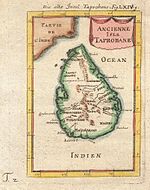Crisis of the Sixteenth Century
| History of Sri Lanka | ||||||||||||||
|---|---|---|---|---|---|---|---|---|---|---|---|---|---|---|
 | ||||||||||||||
| Chronicles | ||||||||||||||
|
||||||||||||||
| Periods | ||||||||||||||
|
||||||||||||||
| By Topic | ||||||||||||||
|
||||||||||||||
The Crisis of the Sixteenth Century was the later part of the Transitional period of Sri Lanka, that began with the decline of the Kingdom of Kotte, with the Vijayabā Kollaya (the spoiling of Vijayabahu) in 1521, culminated in the collapse of the Kingdom of Sitawaka, and with Portuguese dominance of Sri Lankan coasts, if not control by 1597, over two of three kingdoms that had existed at the start of the century.[1] The Kingdom of Kandy was the only independent Sinhalese kingdom to survive.[2] The period was characterised by the fragmentation of the Sinhalese polity, intervention of foreign forces and constant military conflict.
Overview
Periodization of Sri Lanka history:
| Dates | Period | Period | Span (years) | Subperiod | Span (years) | Main government |
|---|---|---|---|---|---|---|
| 300,000 BP–~1000 BC | Prehistoric Sri Lanka | Stone Age
|
– | 300,000 | Unknown | |
| Bronze Age | – | |||||
| ~1000 BC–543 BC | Iron Age
|
– | 457 | |||
| 543 BC–437 BC | Ancient Sri Lanka | Pre-Anuradhapura | – | 106 | Monarchy | |
| 437 BC–463 AD | Anuradhapura | 1454 | Early Anuradhapura
|
900 | ||
| 463–691 | Middle Anuradhapura
|
228 | ||||
| 691–1017 | Post-classical Sri Lanka | Late Anuradhapura
|
326 | |||
| 1017–1070 | Polonnaruwa | 215 | Chola conquest | 53 | ||
| 1055–1232 | 177 | |||||
| 1232–1341 | Transitional | 365 | Dambadeniya
|
109 | ||
| 1341–1412 | Gampola
|
71 | ||||
| 1412–1597 | Early Modern Sri Lanka | Kotte
|
185 | |||
| 1597–1815 | Kandyan | – | 218 | |||
| 1815–1948 | Modern Sri Lanka | British Ceylon | – | 133 | Colonial monarchy | |
| 1948–1972 | Contemporary Sri Lanka | Sri Lanka since 1948 | 76 | Dominion | 24 | Constitutional monarchy |
| 1972–present | Republic | 52 | Unitary semi-presidential constitutional republic |
See also
- Crisis of the Third Century – a similar period in Roman history
- Sengoku period – a similar period in Japanese history
- Warring States period – a similar period in Chinese history
References
Citations
- ^ De Silva 2014, p. 161.
- ^ De Silva 2014, p. 162.
Bibliography
- De Silva, K. M. (2014). A history of Sri Lanka ([Revised.] ed.). Colombo: Vijitha Yapa Publications. ISBN 978-955-8095-92-8.
